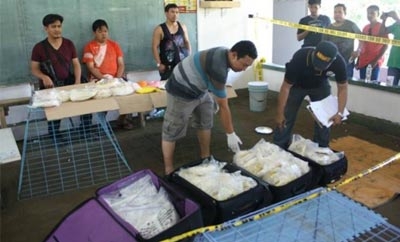Security forces in the Philippines say the Sinaloa Cartel has dispatched a hit squad to silence arrested associates showing just how far from home Mexico’s primary drug cartel is migrating to capitalize on expanding global drug markets.
The director of the Philipino National Bureau of Investigation (NBI), Virgilio Mendez, said foreign anti-narcotics agents had informed him of the imminent arrival of assassins to eliminate Sinaloa Cartel operatives arrested in a drug raid last month, reported the Philippine Daily Inquirer.
During the raid, police seized 84 kilos of methamphetamine, worth around $9.4 million locally, reported the Associated Press. Authorities have singled out the owner of the property where the drugs were found, a Filipino-American named Jorge Torres, as the primary contact for the Sinaloa Cartel in the country. They later arrested three Mexicans from Sinaloa state believed to be linked to Torres.
SEE ALSO: Sinaloa Cartel News and Profiles
Court documents related to the case say anti-narcotics police surveillance showed links between the Torres gang and Horacio Hernandez, an alleged “mid-level Sinaloa drug cartel” operative, reported the Inquirer. Hernandez has been in the country since late last year and was believed to be seeking drug connections in a joint operation with a Chinese trafficking ring led by Gary Tan, one of the men arrested in the raid.
Security forces that spoke to the Inquirer said the cartel was not “well-entrenched” in the country and that there were several foreign drug trafficking organizations competing for access to the market.
InSight Crime Analysis
If the details of the Torres case and its fallout are confirmed, then they offer an insight into how the Sinaloa Cartel is attempting to break into new drug markets far from its strongholds in Latin America, the United States and Europe.
At first glance, this does not appear to be a Sinaloa Cartel invasion. Instead, it looks more like a low key building of local contacts with distribution networks. This is consistent with the way the cartel works in other regions outside of Mexico: they seek local allies and channel their operations through them, dispatching overseers and occasionally muscle.
SEE ALSO: Coverage of Criminal Migration
It is this muscle that raises red flags. If it is true the cartel has dispatched assassins to the country, this would be an indication that the Asian market is starting to become more important to the organization.
This not the first time such connections have been highlighted, with Philippines anti-drug czar Arturo Cacdac reporting last year that authorities were investigating connections between Mexican cartels and Chinese gangs manufacturing methamphetamine.
The Sinaloa Cartel is the most powerful of the Mexican cartels, and its reach expands across the globe. It has already established trafficking connections in Australia and is believed to be operating in Asia.
The market is an enticing prospect for the Mexicans. According to the United Nations Office on Drugs and Crime (pdf), Asia is one of the quickest growing cocaine markets, while the Philippines and other countries in the region already have some of the highest amphetamine use rates in the world.

